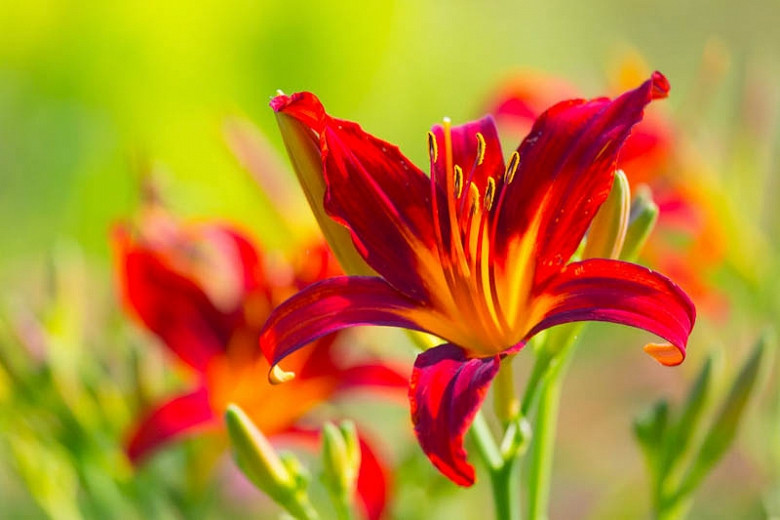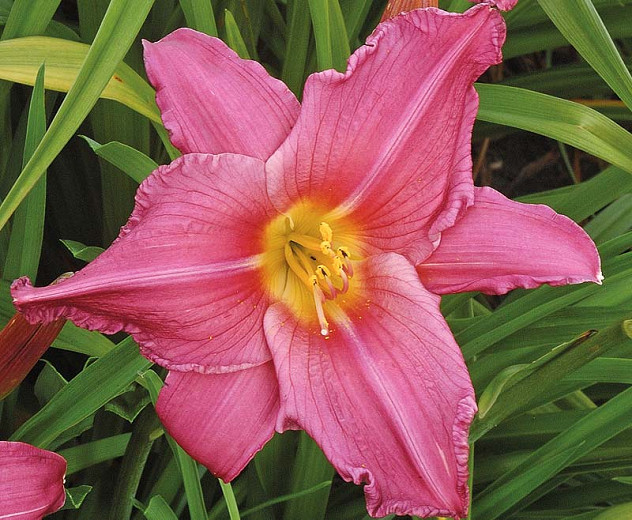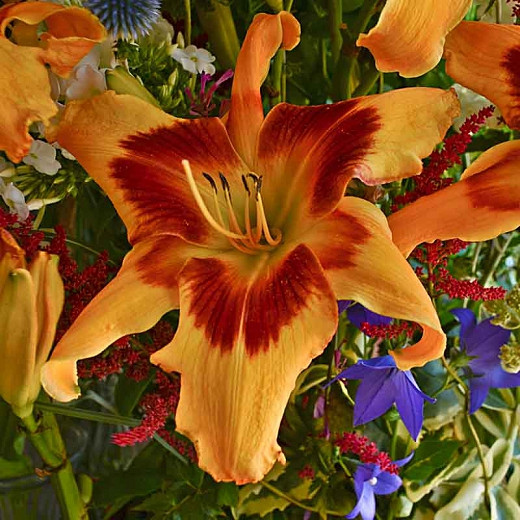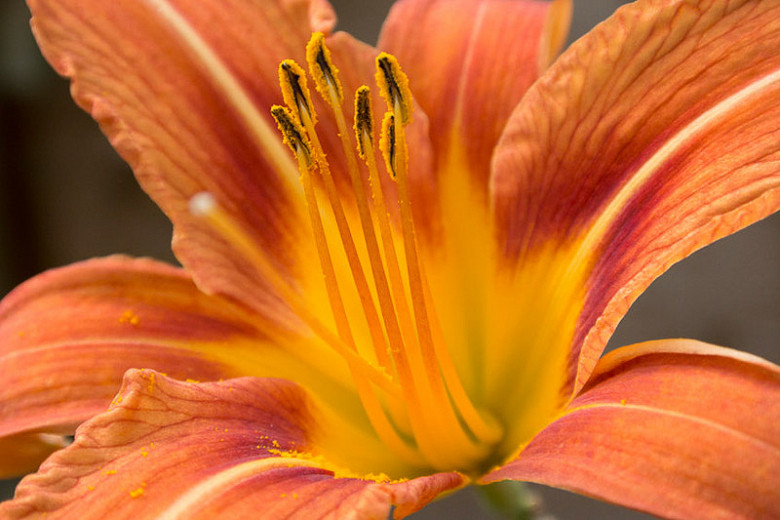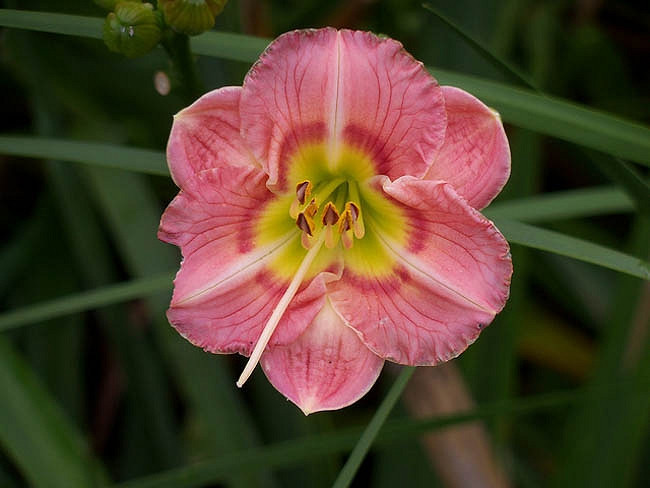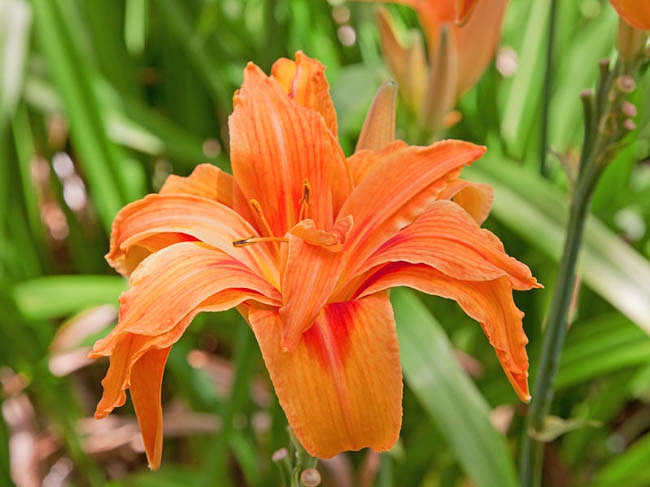Hemerocallis (Daylilies)
Often called the ‘perfect perennial’ because of its numerous qualities: showy flowers, wide array of vibrant colors, drought tolerance, heat stress immunity, ability to grow in most hardiness zones and low care requirements, Daylily (Hemerocallis) is a remarkable and stunning addition to the garden!
Often called the 'perfect perennial' because of its numerous qualities: showy flowers, wide array of vibrant colors, drought tolerance, heat stress immunity, ability to grow in most hardiness zones and low care requirements, Daylily (Hemerocallis) is a remarkable and stunning addition to the garden!
- Each flower typically lasts no more than 24 hours (thus the common name 'Daylily'), opening up in the morning and withering during the forthcoming night, possibly replaced by another one on the same scape (flower stalk) the next day. Some species are night-blooming. They open late in the afternoon and stay open throughout the evening until the morning. If you spend time in the garden late in the day, these are the perfect daylilies for you!
- Daylilies have a relatively short blooming period, 1 to 5 weeks and depending on their variety and your area, they may bloom from early spring until frost. Mixing varieties would prolong their color blossoms in the garden. Native to Eurasia, Hemerocallis includes over 60,000 registered cultivars, so you have plenty of choice! You may select:
'Extra Early' Daylilies: These daylilies are the first to bloom, and vary from March or April in the extreme South, to May or June in the North.
'Early' Daylilies: These daylilies bloom three to five weeks prior to the mass of blooms at mid-season.
'Early Midseason' Daylilies: These daylilies bloom one to three weeks before the height of bloom of most cultivars.
'Midseason' Daylilies: These daylilies bloom at the peak of the daylily bloom in your own garden. This ranges from May in the South to July in the North.
'Late Midseason' Daylilies: These daylilies bloom one to three weeks after the height or peak of bloom in your garden.
'Late' Daylilies: These daylilies bloom when most others have finished blooming, usually four to six weeks after the peak of the season.
'Very Late' Daylilies: These daylilies are the last to bloom, often late in the summer in the South, fall in the North. - Some varieties are 'reblooming'. These daylilies bloom more than one time during a single season. Some of these bloom early (e.g., May or June) and then repeat in the fall. Others have a succession of bloom periods, one shortly after another for several months.
- Daylilies foliage is also a lovely asset as it provides texture and color when the flowers are not in bloom. The foliage may be dormant (the leaves die back in winter), evergreen (these Daylilies keep their leaves throughout the year. In mild climates, they remain green all winter) or semi-evergreen.
- Ideal choice for shrub borders or perennial beds, as ground covers on slopes or in containers near the patio. Attracts butterflies and hummingbirds!
- Thriving in full sun or part sun in average, moist, well-drained soils, they are relatively free of pests. While Daylilies perform well in a wide range of soils, fertile loam is preferred. Tolerate heat and summer humidity but thorough watering is required to ensure the foliage remains attractive!
- The best time to plant Daylilies is during the early fall or early spring.
- After flowering, remove spent blooms and seedpods to improve appearance and encourage rebloom. When all the flowers on a scape are finished, cut off the scape close to ground level. Remove dead foliage from daylilies as they die back in the fall.
Guide Information
| Hardiness | 3 – 9 |
|---|---|
| Heat Zones | 2 – 11 |
| Climate Zones | 1, 2, 3, 4, 5, 6, 7, 8, 9, 10, 11, 12, 13, 14, 15, 16, 17, 18, 19, 20, 21, 22, 23, 24, H1, H2 |
| Plant Type | Perennials |
| Plant Family | Hemerocallis – Daylilies |
| Exposure | Full Sun, Partial Sun |
| Season of Interest | Spring (Late)Summer (Early,Mid,Late)Fall |
| Height | 1' – 5' (30cm – 150cm) |
| Spread | 1' – 2' (30cm – 60cm) |
| Spacing | 18" – 30" (45cm – 75cm) |
| Water Needs | Average |
| Maintenance | Low |
| Soil Type | Chalk, Clay, Loam |
| Soil pH | Acid, Alkaline, Neutral |
| Soil Drainage | Moist but Well-Drained, Well-Drained |
| Characteristics | Fragrant, Showy |
| Tolerance | Drought, Rabbit |
| Attracts | Birds, Butterflies, Hummingbirds |
| Landscaping Ideas | Beds and Borders, Edging, Patio and Containers |
| Garden Styles | City and Courtyard, Informal and Cottage, Prairie and Meadow, Traditional Garden |
